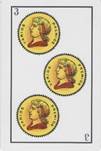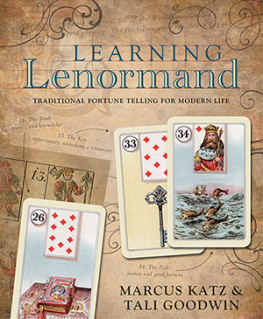Secrets of the Spanish Playing Cards Fortune Telling Using La Baraja Espaola  By Kara Janssen
By Kara Janssen
Copyright 2015 Kara Janssen. All rights reserved. No part of the publication may be reproduced or transmitted in any form, or by any means (electrical, mechanical, photocopying, recording, or otherwise) without the prior written permission of the author, except for brief quotations in critical reviews and certain other non-commercial uses permitted by copyright law. Disclaimer The author disclaims any liability for actions taken on the basis of the interpretations offered in this book.
T ABLE OF C ONTENTS
W HAT I S L A B ARAJA E SPAOLA?
La Baraja Espaola is a deck of Spanish-style playing cards consisting of 40 or 48 cards that is used in Spain and Latin America. The Spanish playing cards can be used for both games and fortune telling purposes .
Playing cards were first brought to Spain by the Moors during the fourteenth century. The Arabic name for a playing card was naib which survived in Spanish as naipe . The pip cards range from ace to nine. Many games and card readers prefer a deck of 40 cards, where the eights and nines are not used. 

 The court cards are numbered ten, eleven and twelve. The tenth card is known as the Jack or the Knave (Sota ).
The court cards are numbered ten, eleven and twelve. The tenth card is known as the Jack or the Knave (Sota ).
The eleventh card is the Knight (Caballo ). The twelfth card is the King (Rey ). The is no queen in the Spanish deck, although in the Mexican pattern the Jacks are all female. The Spanish deck often includes two Jokers (Comodines ) in addition to the full set of 48 cards, bringing the total number of cards to 50. The Spanish playing cards have four suits or palos . These four suits are Coins (Oros ), Cups (Copas ), Swords (Espadas ) and Clubs (Bastos ).
Historically, the different suits referred to different segments of society. Coins symbolized the merchant class, Cups symbolized the clergy, Swords symbolized the nobility, and Clubs symbolized the peasants on the land. 


 There is an inner border on each of the cards called la pinta which identifies each suit. This inner border may be a solid line (Coins), broken once (Cups), broken twice (Swords), or broken three times (Clubs) at both the top and the bottom of the card.
There is an inner border on each of the cards called la pinta which identifies each suit. This inner border may be a solid line (Coins), broken once (Cups), broken twice (Swords), or broken three times (Clubs) at both the top and the bottom of the card. 

 Spanish decks appear in many variations. The Castilian pattern is the most widespread pattern found in Spain.
Spanish decks appear in many variations. The Castilian pattern is the most widespread pattern found in Spain.
It was developed by Heraclio Fournier in 1889 from the older Spanish National pattern. It is easily recognized by its red cups and the coins with faces. 

 The Modern Spanish Catalan pattern is very common throughout both Spain and Latin America. The Cups in this deck are green and yellow and look very much like eggcups.
The Modern Spanish Catalan pattern is very common throughout both Spain and Latin America. The Cups in this deck are green and yellow and look very much like eggcups.  The Mexican pattern appeared in 1923. It is based on the Castilian pattern.
The Mexican pattern appeared in 1923. It is based on the Castilian pattern.
In this deck, all the Jacks (Knaves) are female. This deck usually only contains 40 cards. 

 If your deck has cups that look like golden chalices, then you have the Cdiz or Andalusian pattern of cards. This deck is often used in the Philippines and in some parts of Latin America.
If your deck has cups that look like golden chalices, then you have the Cdiz or Andalusian pattern of cards. This deck is often used in the Philippines and in some parts of Latin America. 

 The least common and oldest pattern is the original Spanish National pattern. In this pattern, the Jack of Coins shows a goat tethered to a pole in the background.
The least common and oldest pattern is the original Spanish National pattern. In this pattern, the Jack of Coins shows a goat tethered to a pole in the background.
This deck is still used in Ecuador and North Africa.  In addition to these common patterns, there are many modern decks based on cartoon characters or which carry commercial advertising.
In addition to these common patterns, there are many modern decks based on cartoon characters or which carry commercial advertising.
H OW T O U SE T HE S PANISH P LAYING C ARDS
Life is like a game of cards. The hand you are dealt is determinism; the way you play it is free will. - Jawaharlal Nehru, Former Prime Minister of India The Question The Spanish playing cards can be used to discover concrete answers to everyday questions revolving around your daily life, such as work, romance, money and health. They can also be laid out in complex spreads that reveal deeper insights into your most spiritual and philosophical questions.
It is important to spend some time to enter a calm, peaceful and relaxed state of mind when framing your question. When you consult the cards, you are consulting the divine to answer your question. Divination is by definition a connection to the divine. You may personally perceive the divine to be part of a traditional religion, a natural force or something more personal. Be specific with your question if you want an answer that is detailed and to the point. A general question will produce a generalized answer, which nonetheless may bring up some unexpected aspects to the question that may surprise you.
Next page












 By Kara Janssen
By Kara Janssen

 The court cards are numbered ten, eleven and twelve. The tenth card is known as the Jack or the Knave (Sota ).
The court cards are numbered ten, eleven and twelve. The tenth card is known as the Jack or the Knave (Sota ).


 There is an inner border on each of the cards called la pinta which identifies each suit. This inner border may be a solid line (Coins), broken once (Cups), broken twice (Swords), or broken three times (Clubs) at both the top and the bottom of the card.
There is an inner border on each of the cards called la pinta which identifies each suit. This inner border may be a solid line (Coins), broken once (Cups), broken twice (Swords), or broken three times (Clubs) at both the top and the bottom of the card. 

 Spanish decks appear in many variations. The Castilian pattern is the most widespread pattern found in Spain.
Spanish decks appear in many variations. The Castilian pattern is the most widespread pattern found in Spain.

 The Modern Spanish Catalan pattern is very common throughout both Spain and Latin America. The Cups in this deck are green and yellow and look very much like eggcups.
The Modern Spanish Catalan pattern is very common throughout both Spain and Latin America. The Cups in this deck are green and yellow and look very much like eggcups.  The Mexican pattern appeared in 1923. It is based on the Castilian pattern.
The Mexican pattern appeared in 1923. It is based on the Castilian pattern.

 If your deck has cups that look like golden chalices, then you have the Cdiz or Andalusian pattern of cards. This deck is often used in the Philippines and in some parts of Latin America.
If your deck has cups that look like golden chalices, then you have the Cdiz or Andalusian pattern of cards. This deck is often used in the Philippines and in some parts of Latin America. 

 The least common and oldest pattern is the original Spanish National pattern. In this pattern, the Jack of Coins shows a goat tethered to a pole in the background.
The least common and oldest pattern is the original Spanish National pattern. In this pattern, the Jack of Coins shows a goat tethered to a pole in the background. In addition to these common patterns, there are many modern decks based on cartoon characters or which carry commercial advertising.
In addition to these common patterns, there are many modern decks based on cartoon characters or which carry commercial advertising.